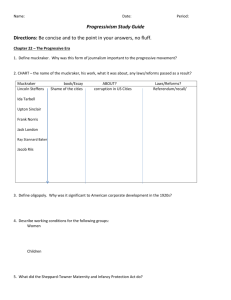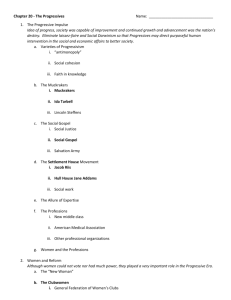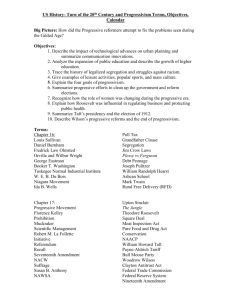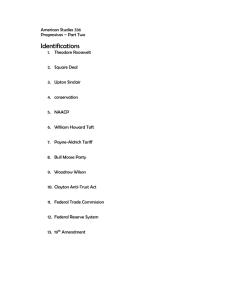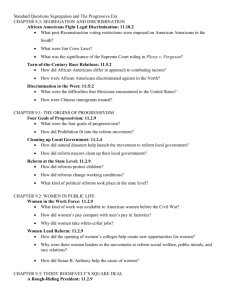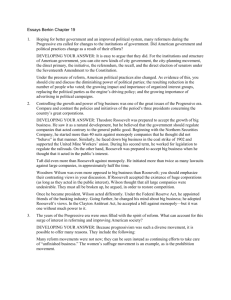In-Class Notes - Whittier Union High School District
advertisement
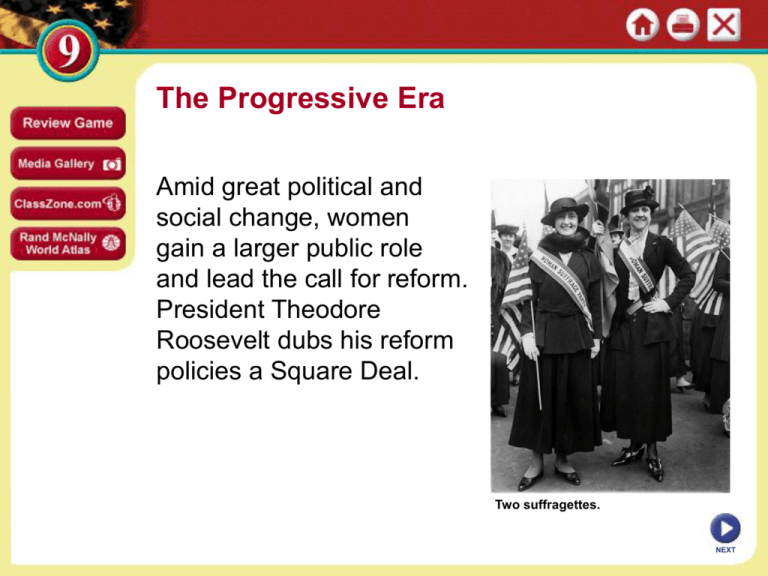
The Progressive Era Amid great political and social change, women gain a larger public role and lead the call for reform. President Theodore Roosevelt dubs his reform policies a Square Deal. Two suffragettes. NEXT The Progressive Era SECTION 1 The Origins of Progressivism SECTION 2 Women in Public Life SECTION 3 Teddy Roosevelt’s Square Deal SECTION 4 Progressivism Under Taft SECTION 5 Wilson’s New Freedom NEXT Section 1 The Origins of Progressivism Political, economic, and social change in late 19th century America leads to broad progressive reforms. NEXT SECTION 1 The Origins of Progressivism Four Goals of Progressivism Concerns of Progressives • Early 1900s, middle-class reformers address problems of 1890s • Different reform efforts collectively called progressive movement • Reformers aim to restore economic opportunity, correct injustice by: - protecting social welfare, promoting moral improvement - creating economic reform, fostering efficiency Continued . . . NEXT SECTION 1 continued Four Goals of Progressivism Protecting Social Welfare • Social Gospel, settlement houses inspire other reform groups • Florence Kelley, political activist, advocate for women, children - helps pass law prohibiting child labor, limiting women’s hours Promoting Moral Improvement • Some feel poor should uplift selves by improving own behavior • Prohibition—banning of alcoholic drinks • Woman’s Christian Temperance Union spearheads prohibition crusade Image Continued . . . NEXT SECTION 1 continued Four Goals of Progressivism Creating Economic Reform • 1893 panic prompts doubts about capitalism; many become socialists • Muckrakers—journalists who expose corruption in politics, business Fostering Efficiency • Many use experts, science to make society, workplace more efficient • Louis D. Brandeis uses social scientists’ data in trial • Scientific management—time and motion studies applied to workplace • Assembly lines speed up production, make people work like machines - cause high worker turnover NEXT SECTION 1 Cleaning Up Local Government Reforming Local Government • Reformers try to make government efficient, responsive to voters • Some cities adopt government by commission of experts • Many use council-manager: people elect council that appoints manager Reform Mayors • Hazen Pingree of Detroit tackles taxes, transit fares, corruption • Socialist Tom Johnson of Cleveland fights corrupt utility companies NEXT SECTION 1 Reform at the State Level Reform Governors • Governors push states to pass laws to regulate large businesses • Robert M. La Follette is 3-term governor, then senator of Wisconsin - attacks big business Protecting Working Children • Child workers get lower wages, small hands handle small parts better - families need children’s wages • National Child Labor Committee gathers evidence of harsh conditions Chart • Labor unions argue children’s wages lower all wages • Groups press government to ban child labor, Continued . . . cut hours NEXT SECTION 1 continued Reform at the State Level Efforts to Limit Working Hours • Muller v. Oregon—Court upholds limiting women to 10-hour workday • Bunting v. Oregon—upholds 10-hour workday for men • Reformers win workers’ compensation for families of injured, killed Continued . . . NEXT SECTION 1 continued Reform at the State Level Reforming Elections • Oregon adopts secret ballot, initiative, referendum, recall • Initiative—bill proposed by people, not lawmakers, put on ballots • Referendum—voters, not legislature, decide if initiative becomes law • Recall—voters remove elected official through early election • Primaries allow voters, not party machines, to choose candidates Image Direct Election of Senators • Seventeenth Amendment permits popular election of senators NEXT Section 2 Women in Public Life As a result of social and economic change, many women enter public life as workers and reformers. NEXT SECTION 2 Women in Public Life Women in the Work Force Changing Patterns of Living • Only middle-, upper-class women can devote selves to home, family • Poor women usually have to work for wages outside home Image Farm Women • On Southern, Midwestern farms, women’s roles same as before • Perform household tasks, raise livestock, help with crops Continued . . . NEXT SECTION 2 continued Women in the Work Force Women in Industry • After 1900, 1 in 5 women hold jobs; 25% in manufacturing • 50% industrial workers in garment trade; earn half of men’s wages • Jobs in offices, stores, classrooms require high school education • Business schools train bookkeepers, stenographers, typists Domestic Workers • In 1870, 70% of employed women do domestic work • Many African-American, immigrant women do domestic labor - married immigrants take in piecework, boarders NEXT SECTION 2 Women Lead Reform Women Get Involved • Many female industrial workers seek to reform working conditions • Women form cultural clubs, sometimes become reform groups Women in Higher Education • Many women active in public life have attended new women’s colleges • 50% college-educated women never marry; many work on social reforms Image Continued . . . NEXT SECTION 2 continued Women Lead Reform Women and Reform • Women reformers target workplace, housing, education, food, drugs • National Association of Colored Women (NACW)— child care, education • Susan B. Anthony of National American Woman Suffrage Assoc. (NAWSA) - works for woman suffrage, or right to vote A Three-Part Strategy for Suffrage • Convince state legislatures to give women right to vote • Test 14th Amendment—states lose representation if deny men vote • Push for constitutional amendment to give women the vote Map NEXT Section 3 Teddy Roosevelt’s Square Deal As president, Theodore Roosevelt works to give citizens a Square Deal through progressive reforms. NEXT SECTION 3 Teddy Roosevelt’s Square Deal A Rough-Riding President Roosevelt’s Rise • Theodore Roosevelt has sickly childhood, drives self in athletics • Is ambitious, rises through New York politics to become governor • NY political bosses cannot control him, urge run for vice-president The Modern Presidency • President McKinley shot; Roosevelt becomes president at 42 • His leadership, publicity campaigns help create modern presidency • Supports federal government role when states do not solve problems - Square Deal—Roosevelt’s progressive reforms Image NEXT SECTION 3 Using Federal Power Trustbusting • By 1900, trusts control about 4/5 of U.S. industries • Roosevelt wants to curb trusts that hurt public interest - breaks up some trusts under Sherman Antitrust Act 1902 Coal Strike • Coal reserves low; forces miners, operators to accept arbitration • Sets principle of federal intervention when strike threatens public Continued . . . NEXT SECTION 3 continued Using Federal Power Railroad Regulation • Roosevelt pushes for federal regulation to control abuses - Elkins Act—stops rebates, sudden rate changes - Hepburn Act—limits passes, ICC to set maximum rates NEXT SECTION 3 Health and the Environment Regulating Foods and Drugs • Upton Sinclair’s The Jungle—unsanitary conditions in meatpacking • Roosevelt commission investigates, backs up Sinclair’s account • Roosevelt pushes for Meat Inspection Act: - dictates sanitary requirements - creates federal meat inspection program Pure Food and Drug Act • Food, drug advertisements make false claims; medicines often unsafe • Pure Food and Drug Act halts sale of contaminated food, medicine - requires truth in labeling Continued . . . NEXT SECTION 3 continued Health and the Environment Conservation and Natural Resources • 1887, U.S. Forest Bureau established, manages 45 million acres • Private interests exploit natural environment Conservation Measures • Roosevelt sets aside forest reserves, sanctuaries, national parks • Believes conservation part preservation, part development for public Map NEXT SECTION 3 Roosevelt and Civil Rights Civil Rights at the Turn of the 20th Century • Roosevelt does not support civil rights for African Americans • Supports individual African Americans in civil service - invites Booker T. Washington to White House • NAACP—National Association for the Advancement of Colored People - goal is full equality among races • Founded 1909 by W. E. B. Du Bois and black, white reformers Image NEXT Section 4 Progressivism Under Taft Taft’s ambivalent approach to progressive reform leads to a split in the Republican Party and the loss of the presidency to the Democrats. NEXT SECTION 4 Progressivism under Taft Taft Becomes President Taft Stumbles • 1908, Republican William Howard Taft wins with Roosevelt’s support • Has cautiously progressive agenda; gets little credit for successes • Does not use presidential bully pulpit to arouse public opinion Continued . . . NEXT SECTION 4 continued Taft Becomes President The Payne-Aldrich Tariff • Taft signs Payne-Aldrich Tariff—compromise bill, moderate tariffs • Progressives angry, think he abandoned low tariffs, progressivism Disputing Public Lands • Conservationists angry Richard A. Ballinger named interior secretary - Ballinger puts reserved lands in public domain • Interior official protests action, is fired, writes magazine exposé • Gifford Pinchot head of U.S. Forest Service - testifies against Ballinger - is fired by Taft NEXT SECTION 4 The Republican Party Splits Problems within the Party • Republicans split over Taft’s support of House Speaker Joseph Cannon • Cannon weakens progressive agenda; progressives ally with Democrats • 1910 midterm elections, Democrats get control of House Continued . . . NEXT SECTION 4 continued The Republican Party Splits The Bull Moose Party • 1912 convention, Taft people outmaneuver Roosevelt’s for nomination • Progressives form Bull Moose Party; nominate Roosevelt, call for: - more voter participation in government - woman suffrage - labor legislation, business controls • Runs against Democrat Woodrow Wilson, reform governor of NJ NEXT SECTION 4 Democrats Win in 1912 The Election • Wilson endorses progressive platform called the New Freedom - wants stronger antitrust laws, banking reform, lower tariffs - calls all monopolies evil • Roosevelt wants oversight of big business; not all monopolies bad • Socialist Party candidate Eugene V. Debs wants to end capitalism • Wilson wins great electoral victory; gets majority in Congress Chart NEXT Section 5 Wilson’s New Freedom Woodrow Wilson establishes a strong reform agenda as a progressive leader. NEXT SECTION 5 Wilson’s New Freedom Wilson Wins Financial Reforms Wilson’s Background • Wilson was lawyer, professor, president of Princeton, NJ governor • As president, focuses on trusts, tariffs, high finance Image Two Key Antitrust Measures • Clayton Antitrust Act stops companies buying stock to form monopoly • Ends injunctions against strikers unless threaten irreparable damage • Federal Trade Commission (FTC)—new “watchdog” agency - investigates regulatory violations - ends unfair business practices Continued . . . NEXT SECTION 5 continued Wilson Wins Financial Reforms A New Tax System • Wilson pushes for Underwood Act to substantially reduce tariffs • Sets precedent of giving State of the Union message in person • His use of bully pulpit leads to passage Federal Income Tax • Sixteenth Amendment legalizes graduated federal income tax Federal Reserve System • Federal Reserve System—private banking system under federal control • Nation divided into 12 districts; central bank in each district NEXT SECTION 5 Women Win Suffrage Local Suffrage Battles • College-educated women spread suffrage message to working-class • Go door-to-door, take trolley tours, give speeches at stops - some adopt bold tactics of British suffragists Catt and the National Movement • Carrie Chapman Catt, head of NAWSA, stresses organization, lobbying • National Woman’s Party aggressively pressures for suffrage amendment • Work of patriotic women in war effort influences politicians • 1920 Nineteenth Amendment grants women right to vote Image NEXT SECTION 5 The Limits of Progressivism Wilson and Civil Rights • As candidate, wins support of NAACP for favoring civil rights • As president, opposes antilynching legislation • Appoints fellow white Southerners to cabinet who extend segregation • NAACP feels betrayed; Wilson self-defense widens rift The Twilight of Progressivism • Outbreak of World War I distracts Americans; reform efforts stall NEXT This is the end of the chapter presentation of lecture notes. Click the HOME or EXIT button.
